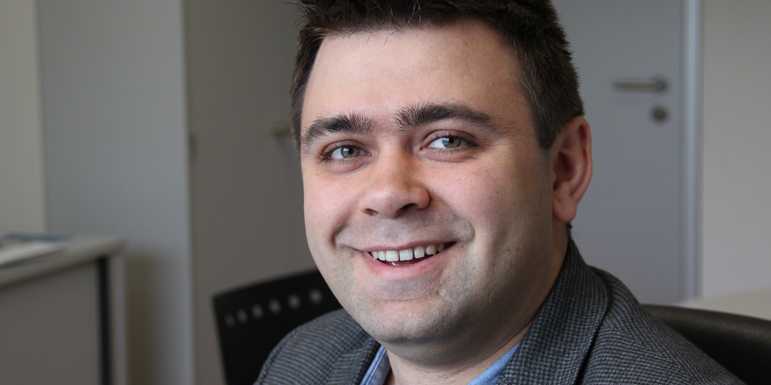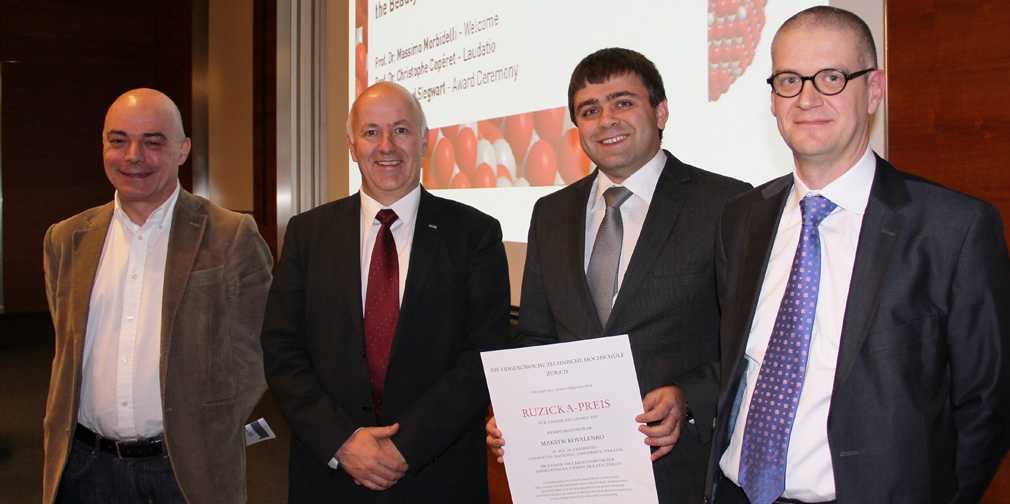Master of nanocrystals
The Ruzicka Prize 2013 has been awarded to ETH Assistant Professor Maksym Kovalenko. The Ukrainian has been very successful at researching new nanomaterials for use in electronics, optics and batteries.
Maksym Kovalenko stands beside his desk, observing his visitor in a curious but reserved way. Like many offices in the finger dock of the HCI, his room is unadorned and fairly small. It doesn’t look like it has been properly set up yet; the 31-year-old Assistant Professor, who has been working at ETH Zurich since July 2011, has simply not had time for this. In addition to the one he is currently standing in, he has a second office at Empa, which means travelling back and forth between Hönggerberg and Dübendorf. Yet, this doesn’t seem to stressed him. On the contrary, Kovalenko comes across as a calm, considerate, almost shy person of few words - until of the conversation turns to his research. He pulls one of his new publications from a pile of special printings to help explain what he is working on: uniform nanocrystals made of tin or antimony, for instance, that could be used in batteries in the future (cf. ETH Life report). He is also very enthusiastic about the present work of his group which deals with sodium-storing materials, a viable low-cost alternative to the present-day lithium-based technology. He wants to create nanocrystals of a size and shape that can be used to significantly improve the energy density of rechargeable lithium-ion and sodium-ion batteries. Above all his goal is to better understand and rationally design the surface chemistry of nanocrystals – as a gateway to their application in nearly every kind of solid-state technology such as electronics, photovoltaics and batteries.
In his young career as a researcher, Kovalenko has already made significant accomplishments, for which he is being awarded the Ruzicka Prize 2013 this evening. An honour that he is delighted to receive as –apart from an ERC Starting Grant in 2012 of 1.8 million Swiss francs – his first most momentous recognition after the start of his independent research career. “This prize really means a lot to me, especially when I reflect on the notable researchers who have already received it”, he says, observing the list of previous awardees. He also adds, “This award will further encourage not only him, but also his group to explore novel and promising inorganic materials.”
Assistant Professor at 29
Kovalenko quickly established himself in the field of nanocrystal research as one of the first to use highly uniform nanocrystals for batteries. Research on battery materials was new territory for the Ukrainian when he took up his position at ETH Zurich. This field of research was linked to the post that he had applied for in the Department of Chemistry and Applied Biosciences. Previously, he had mainly researched the chemical processes that occur on surfaces. However, he emphasizes that he did not have to be asked twice to enter into battery research as the field fascinated him. Kovalenko found it both interesting and important, and recognised that the existing challenges can be addressed with the help of his previous experience in nanocrystal synthesis. “Despite the importance of applied research towards improved batteries, several other projects in our portfolio are purely curiosity-driven. As an example, we study novel kinds of self-organized crystal structures composed of nanocrystals (superlattices)”, explains Kovalenko.
He was born in Ukraine in1982. There he completed his obligatory schooling plus a master’s degree in inorganic chemistry at Chernivtsi National University. He then moved to the West to obtain his doctorate degree. At Johannes Kepler University in Linz (Austria), he received his PhD in nanoscience and nanotechnology in 2007. His doctoral thesis dealt with the synthesis of colloidal nanocrystals for their applications in infrared optical devices. He continued his career at the University of Chicago. There, he worked as a postdoc from 2008 to 2011 and developed new procedures that can be used to tailor the surface chemistry of colloidal nanostructures. With this he laid the foundation for new ways of using nanomaterials for electronics and optoelectronics. In 2011, he accepted a position at ETH Zurich, and since then has been Assistant Professor for Inorganic Chemistry in the Tenure Track process. His group is also partially hosted by Empa, in the Laboratory for Thin Films and Photovoltaics in Dübendorf.
Productive years
Kovalenko now leads a group of eight PhD students and five postdocs, most of whom joined the group in 2013. As a result, he is now much more involved in activities such as team organisation and leadership than he was at the start of his career at ETH. Nevertheless, he tries to maintain personal contact with every one of his group members. “We’ve had a very productive year”, he says with a mischievous smile, “but I think 2014 is going to be even better.”
Ruzicka Prize
The prize, which is named after Nobel Laureate Leopold Ruzicka, has been awarded to young researchers who have made exceptional contributions in the field of chemistry since 1957. The Ruzicka Prize is made possible through funds from the Swiss chemical industry and, together with the Werner Prize, is the most important Swiss prize for promoting young researchers in chemistry. Its board of trustees has discovered many talented people since it was first awarded in 1957: the list of recipients includes names such as Richard Ernst (magnetic resonance) and Charles Weissmann (prion research).


